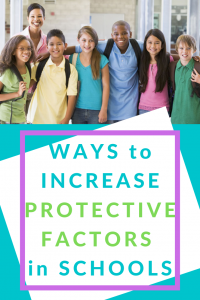
Child maltreatment is associated with a disruption in early brain development and long-term consequences such as behavioral, physical, and mental health problems. Several studies have linked maltreatment to delinquency, and child maltreatment and delinquency to societal problems. Maltreated youth often become “crossover youth” or “dually involved,” which means that they become a part of multiple systems. About 92% of “crossover youth” are first involved in the child welfare system before the juvenile justice system. These youth are 47% more likely to engage in both nonviolent and violent delinquent and criminal behaviors in adolescence and young adulthood.
Maltreated youth experience risk factors in their home environments, and these risk factors increase the likelihood of children engaging in negative behaviors. However, there are “buffers” or protective factors that can help youth counteract these adverse circumstances. Protective factors are strengths and support that buffer against risk by reducing the impact of risk, changing the way the youth responds to it, and allowing the youth to succeed despite the risk. For both nonviolent and violent behaviors, a connection to school can be a strong protective factor for maltreated youth.
 How Schools Can Increase Protective Factors
How Schools Can Increase Protective Factors
School, classroom environments, and experiences play a significant role in the surfacing and persistence of aggressive behaviors in students. A positive school climate is important in motivating students in the learning process. Furthermore, students who receive support from teachers and peers in school are more likely to partake in positive activities and exhibit positive behaviors. Supremely, our goal is to empower youth and increase their self-efficacy so that they feel enabled to succeed despite their circumstances. This can be achieved at school on both micro (individual) and mezzo (school and community) levels.
Daily Personal Interaction
Schools have the power through daily interaction to help children develop and strengthen protective factors and to help shape youth’s beliefs in their abilities to achieve. Teachers, coupled with a positive school climate, can promote resilience, achievement, coping skills, and overall self-efficacy by increasing the ability to manage healthy relationships and resist peer pressure. Some best practices for teachers include caring relationships with students. A teacher can foster caring relationships by:
- Providing support, respect, and compassion
- Maintaining high expectations that help students believe in their resilience and abilities
- Challenging but supporting the students
- Providing stern guidance while maintaining freedom in structure
- Using strengths-focused and student-centered approaches
- Contributing to reframing how students identify themselves and their circumstances
Allow children the opportunity to participate in their learning and engage in interactive group processes and activities that include reflection, dialogue, and critical thinking. Teachers should give children responsibilities in class and invite students to play a part in establishing classroom rules and curriculum. We can empower students in classrooms by encouraging creative expression, providing experiences and opportunities that play to their strengths, and inspiring service to others.
It is also particularly beneficial for teachers and school administrators to engage in trauma-informed practices. Because trauma can impact a child’s development, being trauma-informed requires that educators exemplify social-emotional skills in their actions. When a teacher develops caring and safe relationships infused with hope, this can teach kids how to build relationships and a foundation of trust and hope, which is important to resilience. An educator who has unconditional positive regard for each student can help students feel they are worthy of care regardless of their behavior or experiences. Furthermore, as an educator, try sharing what you are feeling instead of hiding your emotions, and invite the entire class to engage in a positive coping mechanism that you use.
 School Climate, Community-Building and Beyond
School Climate, Community-Building and Beyond
By improving the curriculum, schools can incorporate mental health education and mandatory social workers and counselors on campus. Schools can implement programs, such as peer mediation programs, that improve school climate. Peer mediation programs are designed to increase the protective factors of social and emotional competence and decrease risk factors such as aggression and antisocial behavior. Implementing a peer mediation program or incorporating peer mediation in classes may include:
- Teaching students to negotiate constructive resolutions to their conflicts
- Teaching students to mediate constructive resolutions of their classmates’ conflicts
- Creating a peer mediator selection process that involves selecting peer mediators and rotating these responsibilities among students, thus allowing every student the chance to serve.
Incorporating peer mediation can help youth gain skills like self-regulation, situation assessment, judgment-making, and decision-making to produce the desired outcome. Peer mediation can also help teach peacemaking and autonomy. These are skills that contribute to cognitive and social development.
Finally, investment in schools and ultimately communities, particularly in urban areas and minority communities with high numbers of risk factors, can bolster protective factors. If we know that childhood abuse is linked to adult interpersonal problems and psychological dysfunction, why not help youth while we can? If we do not help youth fight when they are young, we leave them vulnerable to becoming victims of their circumstances. Let’s address these issues at the root through education reform by instilling protective factors in school curriculums.


